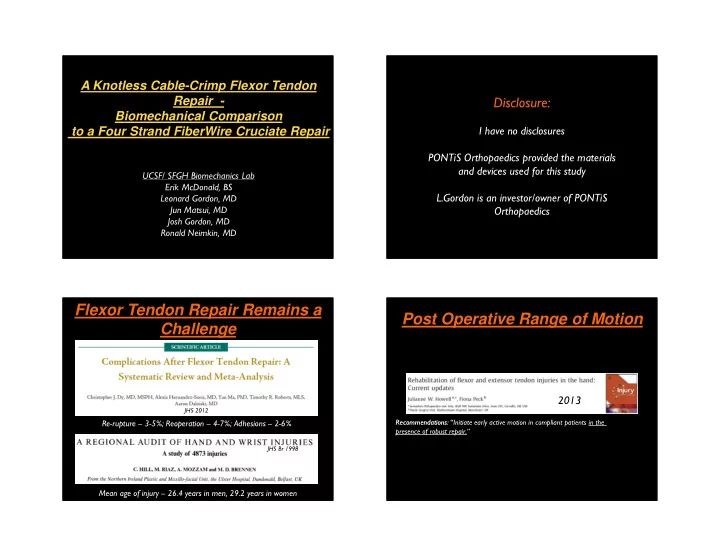

5/10/2013 A Knotless Cable-Crimp Flexor Tendon Repair - Disclosure: Biomechanical Comparison to a Four Strand FiberWire Cruciate Repair I have no disclosures PONTiS Orthopaedics provided the materials and devices used for this study UCSF/ SFGH Biomechanics Lab Erik McDonald, BS L.Gordon is an investor/owner of PONTiS Leonard Gordon, MD Jun Matsui, MD Orthopaedics Josh Gordon, MD Ronald Neimkin, MD Flexor Tendon Repair Remains a Post Operative Range of Motion Challenge 2013 JHS 2011 JHS 2012 Recommendations: “ Initiate early active motion in compliant patients in the Re-rupture – 3-5%; Reoperation – 4-7%; Adhesions – 2-6% presence of robust repair.” JHS Br 1998 JHS Br 1998 Mean age of injury – 26.4 years in men, 29.2 years in women 1
5/10/2013 How can we achieve these ideals? Ideal Core Suture Properties Strickland 1995 – Flexor Tendon Injuries: I. Foundations of Treatment • Sutures easily placed in tendon • Secure suture knots JHS 2011 • Smooth junction of tendon ends • Minimal gapping at repair site • Minimal interference with vascularity Higher ultimate load and stiffness when compared • Sufficient strength throughout healing to to Fiberwire, Ethibond, and permit the application of early motion Supramid stress to the tendon However the repairs are still complex … JHS 2011 OK, but how does it do in a repair? JHS 2013 2
5/10/2013 Repair Technique MFSS Crimp Surgical 8 Fresh Frozen FDP tendons per group Technique exposure cross-lock Fiber Wire JHS 2011 JHS 2013 MFSS Crimp A-3 C-1 A-2 A-3 C-1 A-2 Force of Flexion Testing Repair time 140 % Increase in Force of Flexion MFSS cable-crimp 2-strand -- under 7mins 120 FW cruciate 4-strand -- 12 mins 100 80 Surgical exposure 60 40 Cable-crimp system 2-strand -- 0.6cm 20 0 FW cruciate 4-strand -- 2.1cm 4 Strand 3-0 2 Strand 3-0 Intact Tendon Measured, FW Crimp Repair Performed, Repaired Tendon Measured 3
5/10/2013 Mechanical Testing Results Mode of Failure Results Maximum Load Prior to 2mm 140 140 Ultimate 120 120 Suture Load Ultimate Load (N) N = 8 / group Pull Thru Tendon 100 Break Before 100 Gap (N) 2mm Gap JHS 2011 JHS 2011 80 80 0 JHS 2013 JHS 2013 Fiber Wire 5 3 6 60 60 MFSS 0 8 40 40 20 20 0 0 4 Strand 3- 2 Strand 3- 4 Strand 2 Strand 0 FW 0 Crimp 3-0 FW 3-0 Crimp Conclusions FPL repair thro mini-incision The MFSS Crimp system had reduced surgical exposure, repair times and force of JHS 2011 JHS 2013 3 months flexion while maintaining the strength required for early active range of motion rehabilitation when compared with traditional Fiberwire repairs. 4
Recommend
More recommend